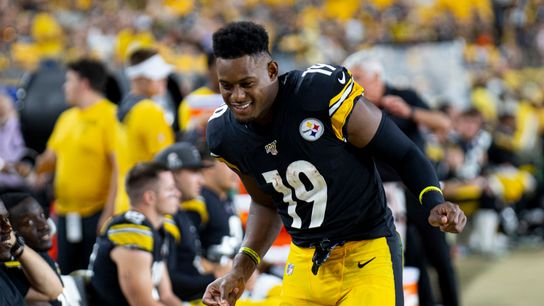A year ago at this time, the question regarding JuJu Smith-Schuster was whether or not he could assume the role of No. 1 receiver with Antonio Brown gone, having been traded away to the Raiders for draft picks.
If 2019 showed us anything, the answer to that question was no.
But that doesn't mean Smith-Schuster is a failure or that he can't still someday be a No. 1 receiver. After all, he is still just 23 years old.
Given his production in his first two seasons, it's more likely his play in 2020 will more closely resemble his 2018 season, when he had 111 catches for 1,426 yards and seven scores, than he will the one who struggled through injuries on his way to 42 catches for 552 yards last season.
Fact of the matter is, the vast majority of receivers in the NFL aren't capable of being a No. 1 receiver. In fact, if you look around the NFL, the total of No. 1 receivers is a very short list. It's a term that gets thrown around far too often, just like "franchise quarterback."
The definition of a No. 1 receiver is cloudy. But the idea is that he should be a player capable of taking over a game. And he'd better be capable of doing it regardless of whether the defense is geared toward stopping him or not.
After all, every team has someone who will lead them in receptions. And most of the time that player is a wide receiver. But that doesn't mean that guy is a No. 1 receiver.
He'd better be able to do more than just be a target hog. For example, Allen Robinson had 154 targets last season for the Bears. It was the third-most targets in the NFL. But nobody considers him a No. 1 receiver.
The true list of No. 1 receivers is a short one. It starts with the Falcons' Julio Jones, Saints' Michael Thomas and now-Cardinals receiver DeAndre Hopkins. All are highly targeted and are capable of taking over a game. The Buccaneers' duo of Mike Evans and Chris Godwin could both be considered No. 1 receivers, though Godwin, like Smith-Schuster the year before, has only done it one season. The Browns' Odell Beckham, Chargers' Keenan Allen and Cowboys' Amari Cooper all have the ability to be No. 1 receivers. Davante Adams of the Packers and the Chiefs' Tyreek Hill round out the list.
That's 10 players who could be considered No. 1 receivers. And two play on the same team, much as Brown and Smith-Schuster shared the spotlight in 2018.
The Seahawks' Tyler Lockett is in the conversation, while the Panthers' D.J. Moore could join that elite status, as well, next season after a solid 2019 season, while Adam Thielen of the Vikings and former teammate Stephon Diggs, now with the Bills, also just miss the cut.
But does a team need a No. 1 receiver?
After all, six of the aforementioned No. 1 receivers played on teams that failed to post a winning record in 2019.
The Patriots have had plenty of success without a true No. 1 receiver -- unless you consider players such as Wes Welker and now Julian Edelman special players. The Patriots haven't had a true No. 1 receiver since they had Randy Moss from 2007 through 2009. That also happened to coincide with the time in past two decades when they weren't winning Super Bowls.
The Super Bowl champion Chiefs have Hill, but they also have All-Pro tight end Travis Kelce and a deep receiving corps capable of taxing a defense.
In fact, prior to last season, you'd probably have to go back to 2015, when Demaryius Thomas was still at the height of his powers to find a case where a team won a Super Bowl with a No. 1 receiver. And Thomas was down the list of true No. 1s at that point.
That brings us back to the initial question, is Smith-Schuster a No. 1 receiver? But perhaps the bigger question that should be asked is does it matter?
The Steelers had a true No. 1 receiver from 2012 through 2018 in Brown. He caught a lot of passes, setting a record for most receptions over a five-year period. And the Steelers won three playoff games along the way.
Brown made a lot of big catches and big plays. But he also demanded a lot of attention. And he made a lot of demands, so much so that it eventually landed him in Oakland.
The Steelers don't necessarily need Smith-Schuster to be a No. 1 receiver as they do for him to simply be a solid contributor. In fact, you could make the argument they would be better off if Diontae Johnson, James Washington and now Chase Claypool, their top pick in this year's draft, share the load with Smith-Schuster, spreading the wealth.
It would make them a much more difficult team to defend.
Would it be nice to have a player capable of taking over a game? Absolutely. But recent history shows that it's more of a luxury than it is a necessity.

Steelers receiver JuJu Smith-Schuster (19) -- MATT SUNDAY / DKPS
Steelers
Is JuJu a No. 1 receiver? Does it even matter?
Loading...
Loading...
THE ASYLUM

Want to participate in our comments?
Want an ad-free experience?
Become a member, and enjoy premium benefits! Make your voice heard on the Steelers, Penguins and Pirates, and hear right back from tens of thousands of fellow Pittsburgh sports fans worldwide! Plus, access all our premium content, including Dejan Kovacevic columns, Friday Insider, daily Live Qs with the staff, more! And yeah, that's right, no ads at all!
We’d love to have you!
